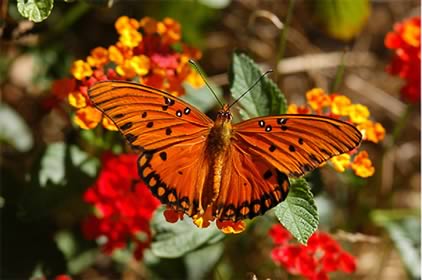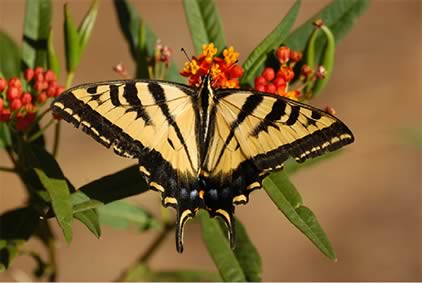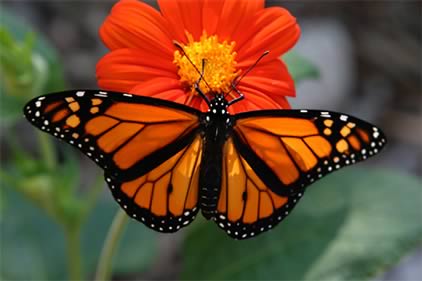|
Butterfly Gardening
Butterflies will visit our gardens if they can find nectar-producing flowers there. By supplying their special environmental needs for both the adult butterfly and the larval or caterpillar stages we can hope to be rewarded with opportunities to observe the fascinating four stages of the butterfly’s life cycle: egg, larva (caterpillar), pupa (chrysalis), and adult. This can provide exciting hands-on natural science experiences for kids in their own gardens.
Explore and Discover
How do butterflies sip nectar?
Can they taste? How?
Look at the coiled tongue and scales on the wings with a magnifier.
What happens if the scales are rubbed off?
Can butterflies and caterpillars hear?
Can a caterpillar bite you?
Where do butterflies go at night or when it rains?
Watch a butterfly emerge from its chrysalis.
The butterfly season in Southern California is normally February to November, but can be affected by weather conditions. Some species can be seen year-round. Most are active on sunny, windless days when the temperature is between 65 and 95 degrees Fahrenheit.
 |
| Gulf Fritillary |
Photo courtesy of Douglas Aguillard |
Prepare Lunch for the Munchers
A butterfly garden can be created by using a small area planted with a few flowering plants that are known to attract a variety of species of butterflies which are common in your neighborhood. Make a list of the butterflies you see and the flowers they are visiting.
 |
| Tiger Swallowtail |
Photo courtesy of Douglas Aguillard |
The flower colors that butterflies seem to prefer are yellow, orange, lavender, and white. In addition to bees, wasps, and other insects that feed on nectar and pollen, butterflies (and moths) are important pollinators.
Each year the numbers and variety of nectar plants in your garden can be increased. Try adding a few caterpillar food plants (host plants) such as dill or wild fennel for the anise swallowtail, mustard or cabbage for the cabbage butterfly, and passion vine for the gulf fritillary. While most adult butterflies feed on nectar from a variety of flowers, caterpillars have different requirements. Some species of caterpillars will munch happily on leaves of several different plants, some will accept only one family of plants, and others will feed on only one genus or species. Native plants attract many species of butterflies. Click this link http://www.cnpssd.org to go to The California Native Plant Society for lists of natives that attract butterflies.
Common Butterflies
Anise Swallowtail
Tiger Swallowtail
Giant Swallowtail
Monarch
Gulf Fritillary
Mourning Cloak
Painted Lady
Buckeye
Sulphurs
Cabbage
Gray Hairstreak
Skippers |
 |
Host Plants
Fennel, Dill, Parsley
Willow, Sycamore
Citrus
Milkweed
Passion Vine
Willow, Elm
Mallow, Hollyhock, Lupine
Plantain, Snapdragon
Cassia
Mustard family
Mallow, Hibiscus
Grasses |
 |
| Monarch Butterfly |
Photo courtesy of Wildscaping |
Nectar plants and host plants can be planted in the same garden with vegetables. Very few butterfly caterpillars cause significant damage to plants in our gardens. However, one that can be a pest on vegetables in the cabbage family (cabbage, broccoli, cauliflower) is the little green larva of the cabbage butterfly. Solution: just pick them off and invite birds to lunch on them!
Caterpillars of many butterflies and some moths (e.g., woollybears) often leave host plants to hide or pupate in brush or woodpiles, and birds will feed on the insects and spiders living there. A “lazy gardener” approach allowing plants to develop seeds and permitting leaf litter, some weeds, and piles of brush, wood and rocks, is recommended for attracting both birds and butterflies and contributing to their survival. It is not necessary to keep your garden completely neat and tidy.
In the children’s book, Charlotte’s Web by E.B. White, Charlotte the spider says, “Life is always better when you’re waiting for something to grow or something to hatch.” While you’re waiting for the plants to grow and the baby birds and caterpillars to hatch, sit quietly among the flowers; for as the saying goes, “if a butterfly lands on you, good luck will be yours for a year”.
For many of us, birds, butterflies, and other animals that inhabit our gardens and yards represent one of our few remaining links with the natural world. Encourage, protect, and ENJOY them!
|


